Posts Tagged ‘Wine Tasting’
June 14th, 2012 •
No Comments As part of the Fancy Food Show which now is in Washington, D.C. annually at the Convention Center (it has been temporarily moved from NYC’s Jacob’s Javit’s Center until renovations are completed), I was invited to a fun chef battle between Iron Chef competitor RJ Cooper and Cordon Bleu Chilean chef Pilar Rodríguez, to take place on Thursday, June 14th, from 1-3pm, at Rogue 24. It was an invitation only media event, in which was able to taste food prepared with authentic Chilean ingredients, paired with Chilean wine and pisco. The new Ambassador of Chile, Felipe Bulnes Serrano, was there to add to the importance of the festivities, but all in all, it was just a fun time!
Here are some photos of the drinks, the Chilean wine, some of the dishes and of course the Ambassador (although, RJ Cooper was in true form, check out the photo!).
Categories: Cocktails, DC Wine Tastings, Embassies, ethnic cuisine, Food and Wine Pairing, wine and food pairing, Wine Professionals
Tagged: chile, Chilean Ambassador, chilean wine, RJ Cooper, Rogue 24, Wine Tasting
January 31st, 2012 •
No Comments 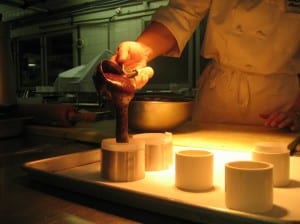 (Note: Updated on February 9th (Thursday) 2012 – will be updated as events unfold or get Sold Out..)
(Note: Updated on February 9th (Thursday) 2012 – will be updated as events unfold or get Sold Out..)
I’ve never been a huge fan of Valentine’s Day, but like Halloween, it’s a celebration/festivity that has taken on a life of it’s own. And 2012 is no exception, there are just a plethora of Valentine’s tastings for both the chocolate and non-chocolate lover – I’m not even sure if the latter exists! Some quick thoughts on Valentine’s and tastings: if you’re a restaurant or event provider who wishes to really draw people in this time of year, any theme with chocolate, sparkling wine (especially Champagne) or some over-the-top rich dish like braised meats seems to bring people in in droves – oh, and also any food/concept connected with Amore, for example oysters and fondue (both chocolate and cheese work). It’s also OK to add terms like “seduction”, “decadent”, “aphrodisiac” and even “libido” to your menu descriptions which breaks away from the everyday norm of exclusion of these concepts – Valentine’s gives you as the marketer the right to explore the racier side of life..and people will accept and forgive you for about a week! Of course, certain cultures are also associated with lasciviousness so French and Italian restaurants and themes have a distinct advantage. If you have a strong combination of all of these themes and concepts, you can also expect a marriage proposal or two to occur – and hopefully, not with your staff!
Oh, and to make all this information just a touch more confusing..Valentine’s Day is officially Tuesday, February 14th, but many events list their date on Saturday or Sunday as “official” Valentine’s Day events – it’s a celebration of love and romance, does it really matter what the official date is? I think not..
I will list the major tastings by date (Note: if you’re just looking for a listing of restaurants that have multi-course dinners especially for Valentine’s, here’s a pretty good list by Washingtonian):
Thursday, February 9th,
Sommelier Showdown (as part of the DC International Food and Wine Festival), 7:00pm-9:00pm
Ronald Reagan Building, 1300 Pennsylvania Avenue Northwest Washington, DC 20004
Tickets are $150/per person and can be Purchased Online
See top DC Sommeliers flex their knowledge at the Washington DC International Wine & Food Festival’s inaugural Sommelier Showdown. Our experts will engage in a friendly tête-à-tête and compete in a race of the taste, using deductive tasting to identify wines with hidden labels.
To complement the wines presented, the Showdown will feature five of DCs most noted chefs who will be tasked with bringing food and wine together, including Chefs Todd Gray (Equinox), Xavier Deshayes (Ronald Reagan Building), and Jaime Montes de Oca (Zentan).
***
SOLD OUT-Savory Syrah – A Global Tour
7 pm
Chain Bridge Cellars, 1351 Chain Bridge Rd. McLean, VA 22101
Wine experts all agree that Syrah is one of the “noble” varietals, capable of making some of the most complex, layered and age-worthy wines in the world. But the kinship between a $10 Aussie Shiraz and a $70 Hermitage is pretty hard to fathom! So take a worldwide tour of everything Syrah/Shiraz can be and see if you can find some common themes. We’ll taste bargains from Australia and the South of France; classic American, South African and Rhone wines; and a couple of “big guns” from the Barosa and Cote Rotie.
This class includes seven wines, Syrah-friendly snacks, and take-home descriptions of each wine and region covered.
To reserve a space, email [email protected] or call 703.356.6500
***
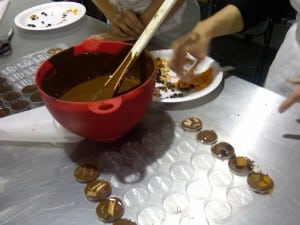
TasteDC Chocolate Making 101 at Wanders Chocolaterie
How to Blind Taste Wine
February 9th (Thursday) Session 1: 6 – 7:30 pm; and Session 2: 8 – 9:30 pm
Adour in The St. Regis, 923 16th and K Streets, N.W., Washington, DC 20006
Wine Director Brent Kroll will conduct a sensory analysis on how to quantify wine flavors and origin.
Tickets are $60/per person.
Call (202) 509-8000 to Make Reservations
***
Categories: Chocolate, cooking classes, dc craft beers, DC Wine Classes, DC Wine Tastings, Foodie, tastedc, Uncategorized, wine classes, Wine Dinners, Wine Tasting
Tagged: aphrodisiac foods, art of dessert, barleywine festival, Bazin's on Church, beer dinners, Beer Festival, Beer Tasting, Beer-Pairing Dinner, bitters, Book Signing, bread and brew, busboys & poets, Champagne tastings, Charlie Adler, cheese shop, chocolate, chocolate and champagne, chocolate and wine pairing, chocolate tastings, Cocktail classes, coco sala, Columbia Room, Conference, cooking class, cooking classes, cooking with chocolate, culinaerie, culinaria cooking school, culinary events, d.c. wine, dc beer dinners, dc tastings, dc valentines, dc wine classes, dc wine dinners, Derek Brown, Fabbioli Cellars, Food and Wine Pairing, Food Festival, Food Tasting, Franciscan Estates, Fund Raiser, Holiday/Special Occasion Meals (examples: Mother's Day, idrinkonthejob, liquor store, Loudoun Valley Vineyards, madfox brew pub, media event, mixology class, Mt. Veeder, Notaviva Vineyards, Passenger, Personal Appearance, Port City Brewery, Prix Fixe Meals, Retail store: In-store tastings, samples or demonstrations, Seminar, sparkling wine tastings, Spirits Tasting, Tarara Winery, tea tasting, Thanksgiving), tudor place, Valentine, Valentine Day, valentine's chocolate tasting, Valentine's Day, vineyard, Wine Auction, Wine Bar, wine basics, wine festival, Wine School, wine store, Wine Tasting, wine tasting dc, wine tastings dc, Wine-Pairing Dinner, winery, Workshop
December 25th, 2011 •
No Comments OK, it’s just a bunch of photos from past TasteDC events, but it kind of shows you where TasteDC comes from – it’s my imagination of how people really would like to eat and drink..a bit of a dream world, but food is so much more than nourishment..Just Enjoy!
Charlie Adler, Managing Editor
TasteDC Food and Drink Event Calendar
“Educate Your Palate”
Categories: Uncategorized
Tagged: beer dinners, capital wine school, Charlie Adler, cooking classes, d.c. wine, dc wine classes, dc wine scene, dc wine schools, food and drink calendar, I Drink on the Job, idrinkonthejob, Taste Calendar, tastedc, TasteDC Calendar, washington wine academy, whiskey dinners, Wine and food matching, wine basics, wine classes dc, wine dinners, wine education, wine education dc, wine festivals, Wine Tasting, wine tasting dc, Wine tasting descriptors, WSET
December 25th, 2011 •
No Comments 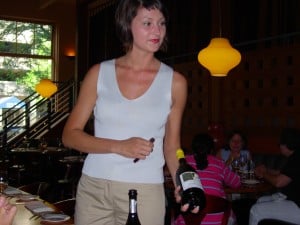 I spent over 15 years organizing and attending wine dinners at TasteDC – it is definitely my favorite part of being in a unique business! Weird as it may seem, a “wine dinner” is conceptually as confusing as a wine tasting to most people – it’s a very foreign concept to many Americans – literally! A wine dinner is in essence a multi-course dinner served with several different wines – this is the simple explanation. A GOOD/GREAT wine dinner is when the various elements come together in a wonderful symphony of an event: wine, food, timing, pairing, educational component (this usually means a speaker), and impeccable service. It sounds very snooty, but that’s primarily because it’s based on the fine dining traditions of the Old World – particularly France and Italy. So what IS a wine dinner?
I spent over 15 years organizing and attending wine dinners at TasteDC – it is definitely my favorite part of being in a unique business! Weird as it may seem, a “wine dinner” is conceptually as confusing as a wine tasting to most people – it’s a very foreign concept to many Americans – literally! A wine dinner is in essence a multi-course dinner served with several different wines – this is the simple explanation. A GOOD/GREAT wine dinner is when the various elements come together in a wonderful symphony of an event: wine, food, timing, pairing, educational component (this usually means a speaker), and impeccable service. It sounds very snooty, but that’s primarily because it’s based on the fine dining traditions of the Old World – particularly France and Italy. So what IS a wine dinner?
“A Wine Dinner Is a Meal Divided by Courses”
Most wine dinners include a menu of dishes served in three or more courses. For example, when you go out to eat at a fine dining restaurant, the menu is often broken down into Appetizers, Main Dishes, and Desserts. A Wine Dinner is a smart way for a restaurant to showcase both great wine and delicious dishes that showcase their chef’s talents. And yes, there is a formula: according to the traditional European format for a dinner (actually, any serious meal!) is begin with the lightest dishes, move on to richer dishes and finish with dessert – and yes, often there is a cheese course before dessert. A very simple multi-course dinner (with or without wine, but in the European tradition, food is pretty much always served with wine) would begin with some hors d’oeuvres, a seafood or pasta dish, a light meat dish (chicken or pork), a rich meat dish (beef or lamb) and dessert. Each course would be served with a different wine in a wine dinner and possibly even more than one wine per course. This would be called a 4-course dinner because hors d’oeuvres are usually not considered a dish, so don’t count in the number.
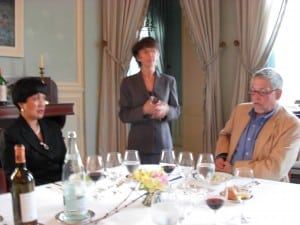
“Each Dish Should Be Paired with the Appropriate Wines”
I’ve been to wine dinners where there is only one wine paired with each dish, and that can be very satisfying! But I’ve also been to wine dinners where there are two, three, even four wines paired per dish (that’s a single dish!) and those can be very fun – albeit confusing at times. I want to touch upon the concept of pairing: pairing wine and food means there’s a synergy of flavor that is 1 + 1 is GREATER than 2. There are some classic examples of pairings: Sauvignon Blanc and goat cheese, Pinot Noir and salmon, and Cabernet Sauvignon and steak, etc. that work but I’ve had pairings that stretch the limits. The original old school formula for pairings was “white wine with fish and red wine with meat” but this is extremely outdated – creative chefs today don’t serve simply prepared dishes that are formulaic, they often prefer to add unique flavors and cooking techniques to their dishes that can be difficult to pair. To keep it simple (I wrote a whole chapter on pairing in “I Drink on the Job” entitled “A Meal Without Wine is Breakfast”). Just like with food, most wine dinners begin with lighter-style wines (like Sauvignon Blanc and Riesling) and move to heavier-bodied wines later in the meal – this makes sense – you wouldn’t want a Big Cab with your shrimp dish/course at the beginning of the meal, that would be way too heavy early in the meal (and a poor pairing!). Also, later in the meal, your palate needs richer and bolder flavors or you won’t notice a dish, so big wines and red meat (or dishes that are braised/slow cooked to increase the rich flavors of a meal) make sense.
A quick note on pairing/wine dinners – most have a theme like “Italian Wines” or “California Boutique Wines” that create the expectation of a special celebration of a wine region or theme. This is important because a wine dinner is a “showcase” event – a chance for a wine maker to show his/her best efforts in the vineyard or a display of a chef’s talents to create gourmet offerings. The point is that usually either the wine or the food is the main center of the wine dinner, one almost always overshadows the other. For example, I attended a wine dinner a few years ago with MacArthur/Addy Bassin’s Liquor where there were over 20 boutique California wines served – yes, the food was excellent at the Mandarin Oriental in Washington, D.C. (I think it was 7-Courses, but I forget!), but every wine was introduced before each course by either the wine maker or a representative who intimately knew the wines – educational and exhilarating!
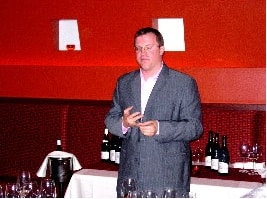
“A Speaker Needs to Introduce the Wines at the Wine Dinner”
Not particularly profound, but someone needs to talk about the wines at a wine dinner and the more knowledgeable, the better. Normally, the wine maker or a representative from the wine community talks about the wines with each dish. Some speaker’s introduce the wines before each course, but this can be detrimental: it can add too much time to a dinner and it can get tedious for attendees! Most people don’t want to sit for more than three hours or so at a wine dinner (including breaks – hey, with all that wine, you may need to visit the bathroom!) so the length of an event is important. I always suggest that the wine professional speaker introduce their wines at the event, maybe speak once in the middle of the meal and then at the end of the meal. Most people at these events would rather talk privately to the speaker, so walking around and “schmoozing” with dinner attendees is a smart move.
Things I haven’t covered in this wine dinner discussion include the importance of speedy service, event duration, popular themes for wine dinners, and the myriad of service issues with this type of event. Staffing is VERY important – experience really makes a difference. One of the most impressive wine dinners I ever went to with the wines of Chateau Pontet-Canet at the Willard Hotel in Washington, D.C. was because of one factor: the Sommelier Caterina Abbruzzetti decanted every one!
Of course, there aren’t only wine dinners: In 14 years at TasteDC, I’ve attended craft beer dinners, whiskey dinners, Tequila Dinners, Cocktail Dinners, Rum Dinners and innumerable conceptual “dinners”, often unique and unusual, but one thing they all had in common – the dishes and the beverage were paired in some way..Hope this all whets your appetite – Cheers!
Charlie Adler, Managing Editor
TasteDC Food and Drink Event Calendar
“Educate Your Palate”
Categories: DC Wine Tastings, Food and Wine Pairing, Restaurant, Uncategorized, wine and food pairing, Wine Dinners
Tagged: beer dinners, capital wine school, Charlie Adler, cooking classes, d.c. wine, dc wine classes, dc wine scene, dc wine schools, food and drink calendar, I Drink on the Job, idrinkonthejob, Taste Calendar, tastedc, TasteDC Calendar, washington wine academy, whiskey dinners, Wine and food matching, wine basics, wine classes dc, wine dinners, wine education, wine education dc, wine festivals, Wine Tasting, wine tasting dc, Wine tasting descriptors, WSET
December 18th, 2011 •
No Comments This is Part 2 of organizing a wine tasting (Part 1 Here) – I get the phone call “we want to organize a wine tasting for a <birthday/celebration/housewarming/shower/corporate event/bachelorette party> can you help?” My first question…DO YOU HAVE A VENUE? Reply – total silence, I can literally hear crickets churping..then the mumbling and nervous reply “well, uhhh, no, uhhh (thinking to themselves “you mean I have to think of everything??”) and then often something like “somewhere in DC, Virginia or Maryland”..and now I’m at a loss of words..
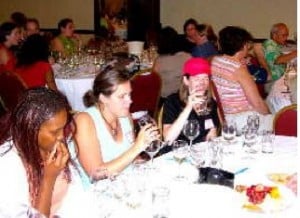
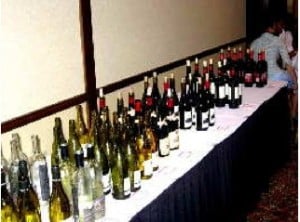 Unless your people can teleport wine into their faces, you MUST FIND A VENUE! OK, but how? Couple thoughts..the most obvious venue is the place you work or hangout, maybe someone’s home. Before you make the phone call to a Professional Event Planner (that’s what wine speakers/professionals become from necessity – we have no choice!), ask a friend/co-worker if they know a nice place to hold a wine tasting. Most likely, a short brain-storming session will begin and potential spaces will be considered – someone’s new home, a great meeting place the group already frequents, a winery, etc..DO THIS BEFORE YOU MAKE THE CALL..OK, I have a confession..
Unless your people can teleport wine into their faces, you MUST FIND A VENUE! OK, but how? Couple thoughts..the most obvious venue is the place you work or hangout, maybe someone’s home. Before you make the phone call to a Professional Event Planner (that’s what wine speakers/professionals become from necessity – we have no choice!), ask a friend/co-worker if they know a nice place to hold a wine tasting. Most likely, a short brain-storming session will begin and potential spaces will be considered – someone’s new home, a great meeting place the group already frequents, a winery, etc..DO THIS BEFORE YOU MAKE THE CALL..OK, I have a confession..
Over HALF the phone calls I receive requesting a wine tasting are VENUE SEEKERS, ie. they could care less about a wine tasting, they just want to squeeze my brain for all the venues I know and just work directly with them..But that’s another Subject!
Back to your needs..hotels and restaurants should be your last choice – why? Because they charge many fees that raise the cost quickly and significantly: room/rental fees, food minimums, corkage fees for wine (a little more on this below..), plus taxes and surcharges on top of all that. Many restaurants and hotels don’t allow an outside vendor to bring wine into their facility – of course – they can sell their own wine to you for a 250-400% markup (this is a common cost multiplier – a $6 store bought wine being sold in a hotel for $21.50 to $30 a bottle ++)
Since cost is a major factor to over 90% of the people that call requesting a wine tasting, think cost first – a free venue is the best. What free venues are available to most people? A home comes to mind first, so contact friends who have a nice place, or who for whatever reason (Ego!) want to show-off their abode. What about an apartment complex – many have community rooms that are empty most of the time, and if you know someone who’s a tenant in the complex, that helps a bunch! Some other potential “free” or low-cost venues include office spaces, office building atriums, art galleries, and non-profit spaces. A note about art galleries and other public venue – they may have quite a few restrictions..well, that’s another article, Cheers!
Charlie “I Drink on the Job” Adler – Check out my book NOW Available on Kindle or Soft-Cover – I Drink on the Job
Categories: Uncategorized
Tagged: beer dinners, capital wine school, Charlie Adler, cooking classes, d.c. wine, dc wine classes, dc wine scene, dc wine schools, food and drink calendar, I Drink on the Job, idrinkonthejob, Taste Calendar, tastedc, TasteDC Calendar, washington wine academy, whiskey dinners, Wine and food matching, wine basics, wine classes dc, wine dinners, wine education, wine education dc, wine festivals, Wine Tasting, wine tasting dc, Wine tasting descriptors, WSET
December 11th, 2011 •
No Comments I’ve organized or promoted over 1,000 wine tastings and wine classes in the Washington, D.C. area since 1997 through my organization TasteDC.com. A few times a week I get a phone call at headquarters (a room in my Georgetown townhouse with 2 computers, a color printer and a Fax..but it IS Ground Zero for DC wine tastings!) asking me to organize a wine tasting or class for a group of say maybe 15 people. What’s funny/unfortunate/amazing is that the call is almost always the same – THEY HAVE NO IDEA WHAT A WINE TASTING IS OR WHAT THEY’RE LOOKING FOR!
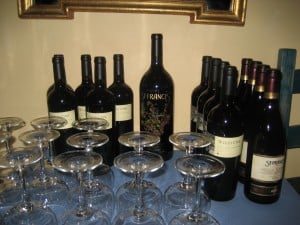 A wine tasting is an event from the TasteDC perspective – it has a beginning time, an ending time and a theme to fill the middle of the tasting. Say for example, a wine tasting of wine styles: rent a room, supply it with glassware (maybe a little food – cheese, crackers and bread would be nice!), a selection of wines with say three different “styles” (could be anything, but normally it might be light-bodied, medium-bodied and heavy-bodied wines) and put them at their own tables with volunteers pouring the wine..or people could pour their own wine – then we suggest you put out an information tasting sheet on each wine..
A wine tasting is an event from the TasteDC perspective – it has a beginning time, an ending time and a theme to fill the middle of the tasting. Say for example, a wine tasting of wine styles: rent a room, supply it with glassware (maybe a little food – cheese, crackers and bread would be nice!), a selection of wines with say three different “styles” (could be anything, but normally it might be light-bodied, medium-bodied and heavy-bodied wines) and put them at their own tables with volunteers pouring the wine..or people could pour their own wine – then we suggest you put out an information tasting sheet on each wine..
RECAP:
- Do you have a Date?
- Do you have a Venue?
- Do you have a wine “theme”?
There are literally thousands of ways to organize a wine tasting! I do want to make note – if you use the term “wine class” that most likely means a seated event with a speaker. Does a wine tasting necessarily need a speaker? No – the simple answer is sometimes (most of the time!) a speaker ads an unnecessary expense to a tasting – speakers charge for their services and the fees range significantly (I start at about $500 per event, but I have other ways to increase my profitability – hey, don’t attendees want a copy of my book “I Drink on the Job” ?
I’m going to write more about what to look for in a wine tasting – both for a private group and for a fun public form of entertainment – keep checking back – Cheers!
Charlie “I Drink on the Job” Adler
Categories: DC Wine Classes, DC Wine Tastings, Food and Wine Pairing, wine classes, Wine Dinners, wine festival, Wine Professionals, Wine Tasting
Tagged: beer dinners, capital wine school, Charlie Adler, cooking classes, d.c. wine, dc wine classes, dc wine scene, dc wine schools, food and drink calendar, I Drink on the Job, idrinkonthejob, Taste Calendar, tastedc, TasteDC Calendar, washington wine academy, whiskey dinners, Wine and food matching, wine basics, wine class, wine classes dc, wine dinner, wine dinners, wine education, wine education dc, wine festivals, Wine Tasting, wine tasting dc, Wine tasting descriptors, WSET
October 27th, 2011 •
3 Comments 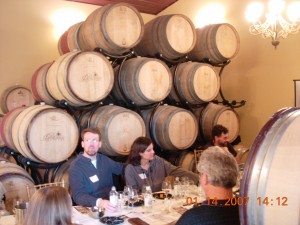
Photo from a TasteDC Wine Making 101 Class in 2007
I knew the day would come, but I was pushing it off as long as possible..after 14 years, over 1,000 wine tastings, 200 cooking classes and dozens of specialty culinary events (Unique Food and Wine Festival, Chorizo Making class, etc.) would I give up TasteDC?? I knew some current facts:
The game had changed post 2008 Recession:
People spent their home’s future value – the ’08 Recession in a nutshell..banks were lending against a home’s equity..or estimated equity..a bubble..yep, it burst, go figure! When you run a small tasting event business, you need to focus on high margin, low volume events – in other words, lots of small wine classes, cheese tastings, and an occasional mini-festival. I never reached Big for the large events preferring to stay with a small staff (often just me and part-time help!) and slowly increasing the number of events. From 1997 to 2007, TasteDC went from organizing one event a month to as many as fifteen a month. When the bubble burst, people didn’t want to splurge – no one wanted to act like they had any disposable income, it just wasn’t the thing to do. My business dropped by over 50%..
Perceptions of value had changed:
In 1999 a wine dinner was something pretty unique and unusual – wine lovers were still a rarified group who often spoke in a language that no one understood. Wine was prestigious, intellectual and sophisticated and the people who drank it often travelled around or had lived abroad, were college educated and possibly even a bit snobbish. Wine dinners – defined as multi-course seated meals with at least one wine paired per course (but often 2 or more wines per course!) and normally a wine presenter discussing the pairings were relatively expensive – a 4 course wine dinner at a fine dining restaurant would cost you $85 to $150 per person inclusive of tax and tip. Believe it or not, many of these dinners sold out at 35+ people and there never seemed to be enough inventory of this kind of event.
Over time, wine became less prestigious and more of a daily consumable – this is actually a good thing. No longer is wine placed on a pedestal, it’s something you can pick up for a meal at the local grocery store or 7-11 and even casual dining restaurants normally carry at least 20 different kinds of wine in the DC area. Economically speaking, wine dinners have actually gone down in price and consumer perception of value – today, a 5-course wine dinner is often under $100 per person, and many of them barely get ten people to sign-up.
And recently, wine dinners are being replaced with the newest premium beverage to hit the DC Foodie scene – craft beer dinners. Most craft beer dinners are 5-courses and under $70 per person inclusive of tax and tip. Craft beer is perceived to be more approachable and fun than wine, so these dinners are often raucous affairs with a younger more urban crowd. Frankly, these dinners are refreshing to the wine dinner scene which seemed to be constantly inundated by the new rich who just wanted to make sure that everyone knew about their newly built wine cellar in their McMansion and the value of their recent stock option sales. Beer is real, or as I often here quoted “It’s just f***ing beer!”
The Groupon Effect:
This only occurred in 2010 or so, but has had a huge impact – when Groupon, LivingSocial and other online coupon companies began to discount restaurants and stores, it was only a matter of time before events and promotions also began discounting. I makes sense – these sites have millions of potential users and they can really bring new customers. The problem is primarily two-fold: the cost of “grouponing” and the “wait and see” attitude it creates.
If your event is say $70/person, then Groupon will suggest 50% off, so they will sell your ticket at $35/person. Groupon makes money by taking 50% of YOUR HALF, so that means you net $17.50 (LivingSocial and some other sites often don’t take as high a percentage). You can see that as a gain of new consumers and some money, but normally an event doesn’t have higher than a 50% margin, and often lower. Events make money once their fixed costs are covered – stating the obvious. Some of an event’s cost is often covered by corporate/retail sponsors, but in a slow economy, these sponsorships are hard to come by – event tickets are the main income..so how do you make money at $17.50/person? Good question..
I know I’ve only touched the surface of this subject, but the bottom-line is that the ROI on tasting events – the wine classes, cooking classes and other tastings that TasteDC specialized in – has become so low, it’s often negative. Will it ever come back? Who knows..Is TasteDC a dead business proposition..well, not quite yet, there is an alternative business plan, and no it is not a discounting concept, stay tuned..
Cheers!
Charlie “I Drink on the Job” Adler
Categories: tastedc, Uncategorized, wine festival, Wine Tasting
Tagged: beer dinners, Charlie Adler, craft beer popularity, d.c. wine, dc wine classes, Food and Wine Pairing, groupon effect, idrinkonthejob, tastedc, wine dinners, Wine Tasting, wine tasting dc
October 2nd, 2010 •
No Comments I hate picky eaters – not with a passion, but totally through self-interest: if you don’t try new things to eat and drink, you won’t be attending any of my wine or culinary events. Why? Because I always add adventurous foods and stories to TasteDC’s Events(blatant plug!) whenever possible. I’ve included in this Post below the complete menu from my 2006 “Unique and Unusual Food and Wine Festival”, check out the menu and click on link for photos.
As an anecdote, last night I taught the Wine Basics 101 class at TasteDC. I told everyone as I often do, that food is way more important than wine – you have to eat, wine is really just an added spice or nuance to the meal, no more. So I told everyone that food would be a primary focus of my introductory wine class – food and wine pairing, talking about food, cooking food, and experiencing food. I always say that if you understand how to cook and balance the flavors of a dish, then wine will come easy to you. I consider wine a missing component in a dish..well, let me digress.. So it was a small class of about 15 people and I noticed alot of ethnic/international diversity – a woman from India, one from Brazil, one from Togo (I think?) in Africa, and then a smattering of Americans from different parts of the country. DC is ethnically diverse. After talking about food and wine for awhile, I began to ask people for their favorite dishes and foods. The Indian woman mentioned she loved butter – which makes sense, because Indian food often incorporates ghee (clarified butter). To a Brazilian woman sitting next to her American boyfriend, I mentioned Feijoada and her eyes lit up – and all across the room most Americans acted disgusted when I mentioned that Feijoada is essentially the leftover parts of a pig stewed with beans – their equivalent to our chili. So I asked her if her boyfriend liked Feijoada..and then the long pause..that uncomfortable pause when a person begins to look for the right thing to say, for that special person to react in a certain way, and for the universe to somehow come to balance..no, her boyfriend didn’t like Feijoada, or for that matter anything she considered delicious, he was an..peanut butter and jelly sandwich addict! I don’t think I need to fill in the details..another woman at the event LOVED to eat food, oh she just adored food, she really enjoyed it..as long as it was white meat chicken “simply” prepared – no sauce, no seasoning, but grilling it was OK..oh, and she also enjoyed salmon..that’s it! Ohh, she had “tried” other foods (she said this in such a way like a young child looking for praise from her mother!) – gold star stuck to the forehead – but she would never consume these foods – too risky, I mean they would taste outside her comfort realm of chicken and salmon, simply prepared..I should have named this article “Peanut Butter and Jelly and a Little Chicken”..
No comment or explanation from me about the American palate – there’s plenty of discussion of that in my book I Drink on the Job – the only adjective that comes to mind is “limited (extremely)”..I’ll post more on this topic soon!
The complete Menu for TasteDC’s “Unique and Unusual Food and Wine Festival” below (Thumbnail Photos – Click to Enlarge – Here – Feel free to Post These Anywere, Permission Granted!
TasteDC’s 1st Annual “Unique and Unusual Food and Wine Festival”
Wednesday, October 25th, 2006
List of Chefs and Dishes:
Chef de Cuisine, James Phillips – Juniper Restaurant, Fairmont Hotel
1. Rattlesnake Gumbo with Sassafras Scented Rice
2. Pink Peppercorn and Wattleseed Crusted Ostrich Leg Roast with Diablo Hollandaise
Lebanese Taverna and 100 King Street
1. Veal Kidney with a Dijon Mustard Sauce – 100 King Restaurant
2. Hindbeh Bil Zayt (sautéed Dandelion Leaves in olive oil with garlic,
parsley, and caramelized onions) – Lebanese Taverna
Executive Chef Dan Wecker, The Elkridge Furnace Inn
1. Nut Crusted Sweetbreads with Pomegranate Syrup
2. Buckwheat Blini with American Caviar and Crème Fraiche
Executive Chef Daniel Labonne, Tabaq Bistro
1. Jerk Frog Legs with Jamaican Spices
2. Caribbean Tripe Stew with Grilled Bananas
Executive Chef Daniel Kenney, and Executive Sous Chef Neal Bailey, Willard Hotel
1. Barolo Braised Veal Cheek with Shropshire” Orange” Blue
2. “Bacon and Eggs”: House Cured Berkshire Pork Belly with Fried Quails Egg
Executive Chef, Russell Cunningham, Dupont Grille, Jury Hotel
1. Calf Fries
2. Smoked Duck and Fried Squash Blossom Salad with Port Reduction and Pumpkinseed Oil
Executive Chef Charlie Hansji, The Jefferson Hotel
1. Beef Bone Marrow and Liver Parfait
2. Lamb Brains in the Style of Peking
Executive Chef Jamie Stachowski, Restaurant Kolumbia
1. Terrine de Tête de Veau
2. Boudin Rouge, Black Mission Fig and Goat Cheese Strudel
Executive Chef, Stefan Jarausch, The Madison, a Loews Hotel
1. Stuffed Squash Blossoms, Braised Pigs Feet, Xerez Gastrique
2. Crostini of Beef Tongue, Basque Style
Executive Chef Bryan of Chef Bryan’s Kitchen
1. Llama Slider with Bleu Cheese and Rosemary Red Onion Jam
2. Grilled Cayman Tail (crocodile) with Smoked Tomato and Basil Butter
Executive Chef, Brian Boots, Elegance Ala Carte
1. Alligator Étouffée
2. Caramelized Fennel, Yucca and Jicama Puree served over Fried Sweet Potato Chips
Executive Chef Daniel Amaya, Dino’s
1. Polipo: Olive Oil Braised Octopus with Cici (garbanzos) and Lemony Vinaigrette
2. Crostata di Formaggi. Erborinato di Pecora Cheese Tartlet: cave aged raw sheep’s
milk cheese with natural bluing. Robiola La Rossa Cheese Tartlet: Cow and sheep
mixed milk cheese wrapped in cherry leaves that are macerated in grappa
As always, from Charlie “I Drink on the Job” Adler
Categories: DC Wine Tastings, Finicky Eaters, Restaurant, Uncategorized, wine classes, Wine Tasting
Tagged: beef tongue, Brazilian, butter, Charlie Adler, crocodile, culinary events, d.c. wine, dc wine classes, Étouffée, feijoada, finicky eaters, idrinkonthejob, innards, llama slider, pb&j, peanut butter and jelly, picky eaters, Rocky Mountain Oysters, Sweetbreads, tastedc, Tête de Veau, unique and unusual, wine class, Wine Tasting
June 16th, 2010 •
No Comments I’ve always enjoyed talking with Ben Giliberti – even when he was the Washington Post wine critic (which lasted for 22 years, he followed the venerable Robert Parker!), he was always accessible in person and frankly, quite humorous! We were walking away from a Chablis tasting in Washington, D.C. and we were discussing his new role as Director of Wine Education at Calvert Woodley when I posed to him the question “how would he use Social Media and the internet to promote wine education?” We went back and forth for a few moments talking about how things had changed in wine over the last few years and then I pulled out the mini HD video camera and filmed him for about 3 minutes or so, see how he did:
Categories: Uncategorized
Tagged: ben giliberti, Calvert Woodley, Charlie Adler, d.c. wine, dc wine classes, idrinkonthejob, Washington Post, wine and food pairing, wine and social media, wine critic, wine education, Wine Tasting, wine tasting dc
March 28th, 2010 •
No Comments 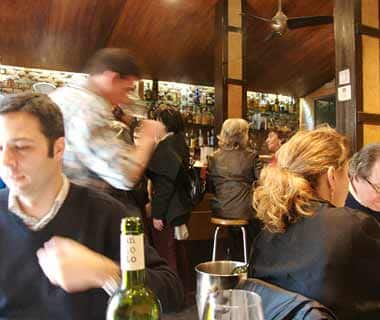
Los Asturianos in Madrid
I recently read this post and photo montage of great wine bars in the world from Travel and Leisure Magazine Europe’s Best Wine Bars and was amazed at the diversity of concepts. I’ve been contacting many wine bars in the Washington, D.C. area recently about their special events and educational wine class offerings and I’m noticing that they all have different concepts of what a wine bar should be. Some local wine bars have a chef and a full menu, while others simply serve charcuterie and glasses of wine. The majority have beer programs as well, but the commitment to beer varies across the board. Almost all have some type of specialty wine preservation system like Enomatic that uses Nitrogen or Argon as inert gases that displace air in the bottle and preserve the wine to some extent.
The question is how does one differentiate what designates a “wine bar” vs. a restaurant? If a restaurant has a bar and they primarily sell wine, does that make the restaurant a wine bar as well? If a wine bar has a chef and also sells wine, does that simply mean it’s a restaurant that sells wine as well? And what about the situation where a wine bar/restaurant also has a license to sell off-premise wine and beer – shouldn’t that be called a wine bartailer? In Virginia, there’s the interesting combination of a restaurant and a separate establishment next door of an off-premise wine retailer. Due to unusual laws, this allows consumers to walk into the wine store, purchase a bottle of wine and consume it next door in the restaurant dining area. Virginia doesn’t allow consumers to bring their own wine into a restaurant (also known as “corkage”) but it does allow these special establishments. These type of restaurants normally charge a fee for the privilege, but it is usually must cheaper to do this than to purchase a wine off a restaurant’s wine list.
I’m going to be doing more research into wine bars and their special event requirements as a I spend more time marketing my services as a wine professional for hire as a wine educator. Future blog posts will cover how wine bars increase their profitability through special events and special programs including private events. Hopefully, this information will help both existing wine bars and potential wine bar owners in their decision-making and will increase the quality and revenue generation of wine bars throughout the world – Cheers!
Categories: Wine Bar, wine classes, Wine Tasting
Tagged: Argon, bartailer, Charlie Adler, corkage, d.c. wine, enomatic, enoteca, idrinkonthejob, tastedc, Wine Bar, wine preservation, wine special events, Wine Tasting, wine tasting dc
 I spent over 15 years organizing and attending wine dinners at TasteDC – it is definitely my favorite part of being in a unique business! Weird as it may seem, a “wine dinner” is conceptually as confusing as a wine tasting to most people – it’s a very foreign concept to many Americans – literally! A wine dinner is in essence a multi-course dinner served with several different wines – this is the simple explanation. A GOOD/GREAT wine dinner is when the various elements come together in a wonderful symphony of an event: wine, food, timing, pairing, educational component (this usually means a speaker), and impeccable service. It sounds very snooty, but that’s primarily because it’s based on the fine dining traditions of the Old World – particularly France and Italy. So what IS a wine dinner?
I spent over 15 years organizing and attending wine dinners at TasteDC – it is definitely my favorite part of being in a unique business! Weird as it may seem, a “wine dinner” is conceptually as confusing as a wine tasting to most people – it’s a very foreign concept to many Americans – literally! A wine dinner is in essence a multi-course dinner served with several different wines – this is the simple explanation. A GOOD/GREAT wine dinner is when the various elements come together in a wonderful symphony of an event: wine, food, timing, pairing, educational component (this usually means a speaker), and impeccable service. It sounds very snooty, but that’s primarily because it’s based on the fine dining traditions of the Old World – particularly France and Italy. So what IS a wine dinner?
 Unless your people can teleport wine into their faces, you MUST FIND A VENUE! OK, but how? Couple thoughts..the most obvious venue is the place you work or hangout, maybe someone’s home. Before you make the phone call to a Professional Event Planner (that’s what wine speakers/professionals become from necessity – we have no choice!), ask a friend/co-worker if they know a nice place to hold a wine tasting. Most likely, a short brain-storming session will begin and potential spaces will be considered – someone’s new home, a great meeting place the group already frequents, a winery, etc..DO THIS BEFORE YOU MAKE THE CALL..OK, I have a confession..
Unless your people can teleport wine into their faces, you MUST FIND A VENUE! OK, but how? Couple thoughts..the most obvious venue is the place you work or hangout, maybe someone’s home. Before you make the phone call to a Professional Event Planner (that’s what wine speakers/professionals become from necessity – we have no choice!), ask a friend/co-worker if they know a nice place to hold a wine tasting. Most likely, a short brain-storming session will begin and potential spaces will be considered – someone’s new home, a great meeting place the group already frequents, a winery, etc..DO THIS BEFORE YOU MAKE THE CALL..OK, I have a confession.. A wine tasting is an event from the TasteDC perspective – it has a beginning time, an ending time and a theme to fill the middle of the tasting. Say for example, a wine tasting of wine styles: rent a room, supply it with glassware (maybe a little food – cheese, crackers and bread would be nice!), a selection of wines with say three different “styles” (could be anything, but normally it might be light-bodied, medium-bodied and heavy-bodied wines) and put them at their own tables with volunteers pouring the wine..or people could pour their own wine – then we suggest you put out an information tasting sheet on each wine..
A wine tasting is an event from the TasteDC perspective – it has a beginning time, an ending time and a theme to fill the middle of the tasting. Say for example, a wine tasting of wine styles: rent a room, supply it with glassware (maybe a little food – cheese, crackers and bread would be nice!), a selection of wines with say three different “styles” (could be anything, but normally it might be light-bodied, medium-bodied and heavy-bodied wines) and put them at their own tables with volunteers pouring the wine..or people could pour their own wine – then we suggest you put out an information tasting sheet on each wine..
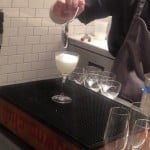


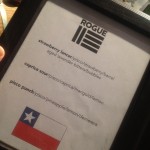

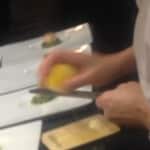
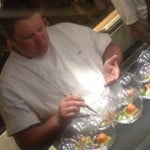
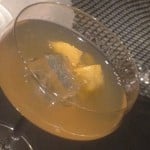
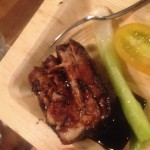

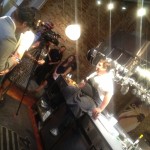












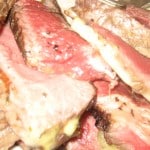

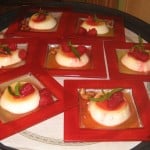
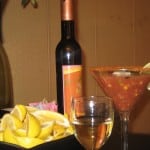
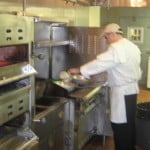




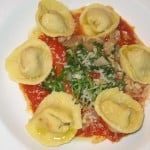









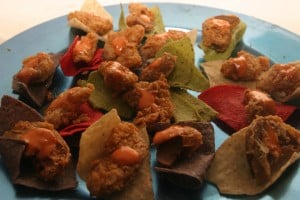 Rocky Mountain Oysters by Executive Chef, Russell Cunningham, Dupont Grille, Jury Hotel
Rocky Mountain Oysters by Executive Chef, Russell Cunningham, Dupont Grille, Jury Hotel





